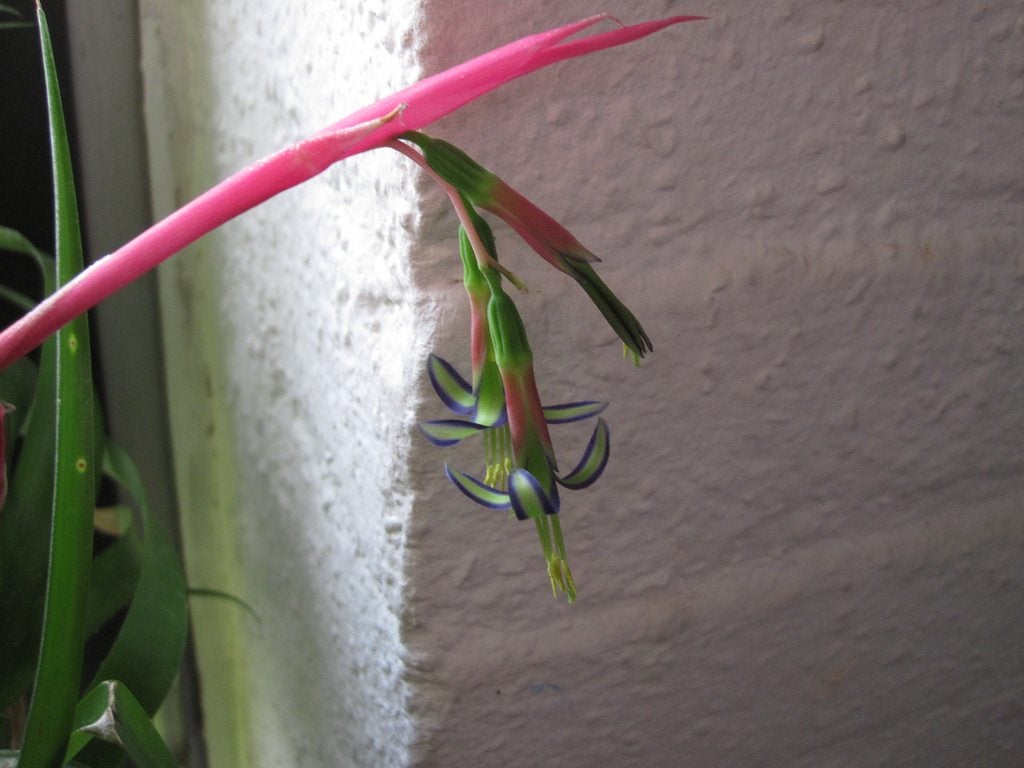Queen’s Tears Plant Care – Tips For Growing Queen’s Tears Plants


Queen’s tears bromeliad (Bilbergia nutans) is a rainbow-colored tropical plant that produces upright clumps of trumpet-shaped, grayish green leaves. Arching stems bear pink bracts and lime green petals rimmed in royal blue. Each long-lasting flower displays a long yellow stamen. Also known as friendship plant, Queen’s tears bromeliads multiply readily and are easily propagated for sharing. Read on to learn how to grow a queen’s tears plant.
Growing Queen’s Tears Plants
Native to South America, queen’s tears is an epiphytic plant that grows primarily on trees but is also found growing on forest floors. It absorbs most of its moisture and nutrients through the flowers and leaves and not from the shallow roots. To grow queen’s tears indoors, plant it in a container filled with potting mix formulated for bromeliads or orchids. If you want to propagate queen’s tears for sharing, separate an offshoot from a mature plant with a sterile knife or razor blade. Plant the offshoot in its own pot. For best results, the offshoot should be at least one-third the height of the parent plant. Place the plant in bright, indirect light throughout most of the year, but move it into light shade during the summer.
Caring for Queen’s Tears
The following tips on queen’s tears plant care will help ensure healthy growth: Queen’s tears bromeliads are relatively drought tolerant. Water frequently during the summer, providing just enough to keep the soil slightly moist but never drenched. Like most bromeliads, you can also fill upward-facing cups with water. Water sparingly throughout winter, early spring, and autumn – just enough to keep the soil from becoming bone dry. Mist the foliage lightly every few days. Queen’s tears bromeliads require warm temperatures of 65 to 80 degrees F. (18-27 C.) during the summer months and slightly cooler temperatures of 60 to 75 degrees F. (16-24 C.) throughout the remainder of the year. Add a water-soluble fertilizer to the irrigation water once every other week during the summer. Use the mixture to moisten the soil, fill the cups, or mist the leaves. Fertilize the plant only once per month during the remainder of the year. Queen’s tears bromeliads usually flower in spring, but stubborn plants can be prompted to bloom by adding a healthy pinch of Epsom salts to the water one time in early spring.
Gardening tips, videos, info and more delivered right to your inbox!
Sign up for the Gardening Know How newsletter today and receive a free copy of our e-book "How to Grow Delicious Tomatoes".

A Credentialed Garden Writer, Mary H. Dyer was with Gardening Know How in the very beginning, publishing articles as early as 2007.
-
 Zinnias On Repeat: 10 Glorious Cut-And-Come-Again Varieties For Endless Summer Bouquets
Zinnias On Repeat: 10 Glorious Cut-And-Come-Again Varieties For Endless Summer BouquetsThese zinnia varieties keep giving all summer, making them the perfect choice for dedicated cutting gardens – or just the occasional homegrown bouquet.
By Ellen Wells
-
 Create A Romantic Garden Straight Out Of Bridgerton: Regency Era Romance In Your Garden
Create A Romantic Garden Straight Out Of Bridgerton: Regency Era Romance In Your GardenTry some romantic garden ideas straight out of Bridgerton. Flowers and gardens in the Regency era were lush and charming and you can get the same look!
By Bonnie L. Grant